Twenty-five Years of Change in Cohabitation in the U.S., 1987-2013
This Family Profile has been updated with new data. Click here to access the most recent version, FP-20-27.
(Updated profiles include: FP-10-07, FP-13-12, FP-15-01, FP-17-02)

Family Profile No. 1, 2015
Authors: Wendy D. Manning & Bart Stykes
This profile presents findings about shifts in the percentage of women who have ever cohabited and cohabited prior to their first marriage over the last 25 years. Relying on indicators of current cohabitation status is informative (NCFMR FP-10-02), but does not capture women’s cumulative experiences with cohabitation. Given the relative short duration of cohabiting unions (about 18 months), it is important to evaluate women’s lifetime experience and not just their status at the time of interview. We provide over two decades of trends on cohabitation by drawing on three published articles (Bumpass and Sweet, 1989; Bumpass and Lu, 2000; and Kennedy and Bumpass, 2008) and a previous profile (FP-10-07) as well as our own updated analyses using the recently released 2011-2013 National Survey of Family Growth (NSFG). For more information about the NSFG, see the 2011-2013 Cycle of the National Survey of Family Growth and the NSFG web page.
Percentage of Women Who Ever Cohabited
- The percentage of women who have ever cohabited has almost doubled over the past 25 years. In 1987, one-third of women had ever cohabited, and in 2011-2013, almost two-thirds (65%) of women 19-44 had ever cohabited.
- All age groups experienced an increase in the share of women who ever cohabited. The age group experiencing the highest levels of cohabitation is women aged 30-34; three-fourths of women between 30 and 34 had ever cohabited as of 2011-2013. Over the 25-year span, the greatest increase (214%) in cohabitation occurred to women aged 40-44, and the smallest increase (45%) occurred to women aged 19-24.
Figure 1. Twenty-five Years of Change in the Share of Women (19-44) Who Ever Cohabited, by Age at Interview
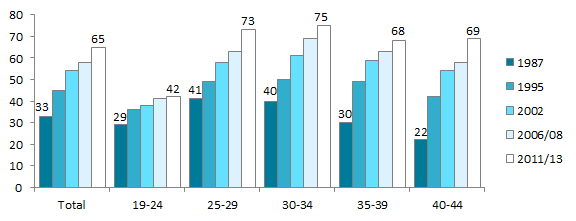
Sources: 1987 NSFH, Bumpass & Sweet, 1989; 1995 NSFG, Bumpass & Lu, 2000; 2002 NSFG, Kennedy & Bumpass, 2008; 2006/08 NSFG (FP-10-07); 2011/13 NSFG, NCFMR Analyses
Percentage of Marriages Preceded by Cohabitation
- Cohabitation continues to be the typical pathway to marriage as over two-thirds (69%) of women who
first married in the last decade cohabited prior to marriage (Figure 2). - The share of women who cohabited prior to marriage increased rather steadily from 11% of first
marriages occurring in 1965-74 to 68% of first marriages occurring between 2000 and 2004. However,
the share of first marriages preceded by cohabitation has remained relatively stable since 2000.
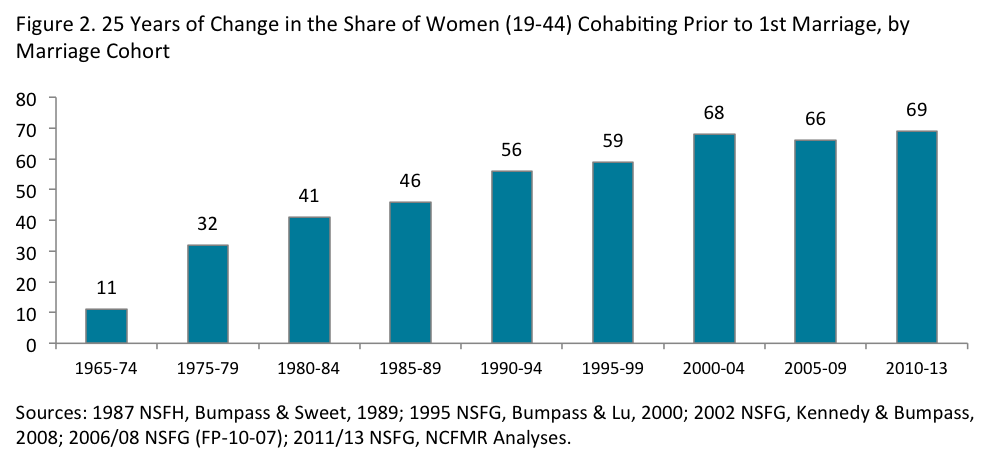
Percentage of All Current Unions that are Cohabiting Unions
- Over one-fourth (28%) of all current unions among women 19-44 are cohabiting unions, increasing by
180% over the last 25 years (Figure 3). - An increasing share of unions among all age groups are cohabitations rather than marriages. Younger
women consistently report a greater share in a cohabiting rather than marital union. The majority, 65%,
of partnered women 19-24 were in a cohabiting rather than marital union.
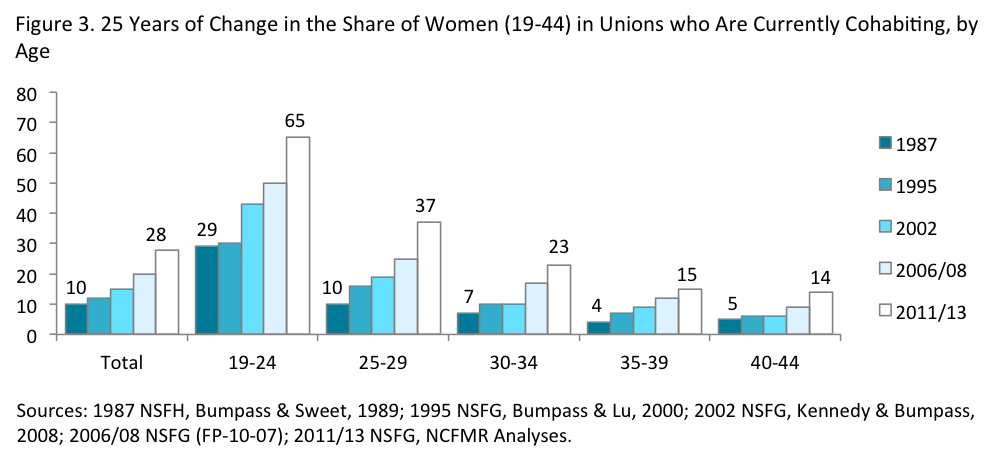
Change in Cohabitation Experience According to Race/Ethnicity
- The share of White and Hispanic women who have ever cohabited has increased steadily over the past 25 years (100% and 113%, respectively). In contrast, the increase in the share of Black women who ever cohabited has leveled.
- In recent years, White and Hispanic women have surpassed Black women in the share who have ever cohabited.
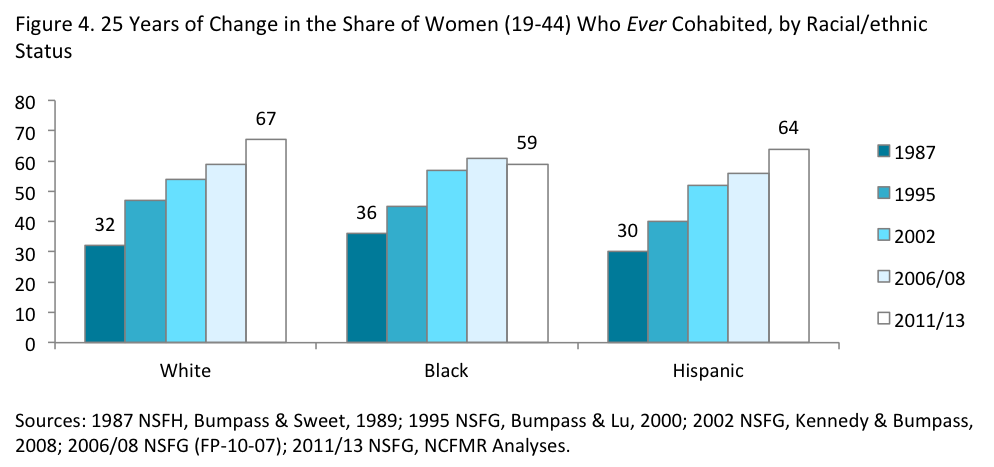
Change in Cohabitation Experience According to Educational Attainment
- In recent years, the share of women who ever cohabited has leveled off for women without high school degrees and high school graduates (Figure 5). Women with some college education or college degrees experienced the greatest increase in cohabitation.
- Across all time points, women with less than 12 years of education report the greatest share who
had ever cohabited. The education gap is growing. In 2011/13, over three-fourths of women with less than 12 years of schooling had ever cohabited compared to 58% of those having at least four years of college experience.
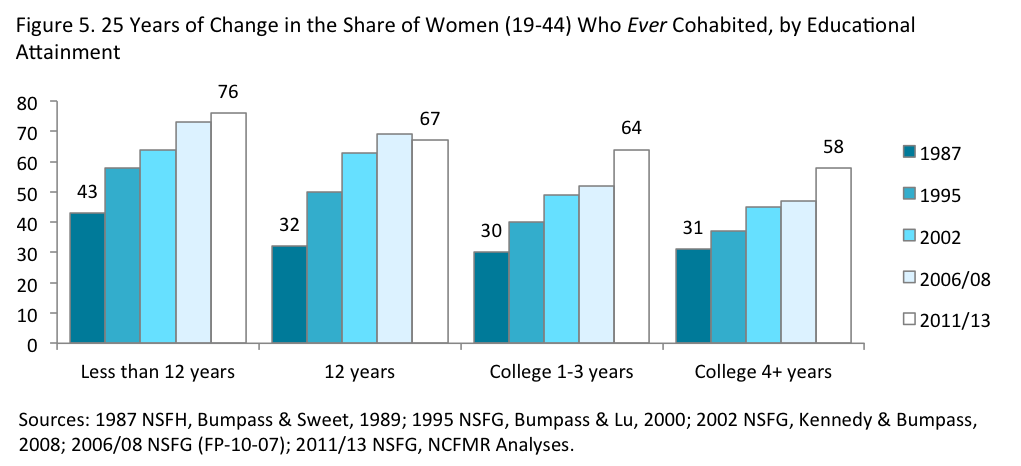
This profile draws on estimates published in the following articles:
- Bumpass, L., & Sweet, J. (1989). National estimates of cohabitation. Demography, 26(4), 615-625.
- Bumpass, L., & Lu, H. (2000). Trends in cohabitation and implications for children’s family contexts in the United States.
Population Studies, 54, 29-41.
- Kennedy, S., & Bumpass, L. (2008). Cohabitation and children’s living arrangements: New estimates from the United States.
Demographic Research, 19, 1663-1692. doi:10.4054/DemRes.2008.19.47
Suggested Citation
- Manning, W. D., & Stykes, B. (2015). Twenty-five Years of Change in Cohabitation in the U.S., 1987-2013. (FP-15-01). National Center for Family & Marriage Research. Retrieved from http://www.bgsu. edu/content/dam/ BGSU/college-of-arts-and-sciences/NCFM/documents/FP/FP-15-01/twentyfive-yrs-changecohab.pdf

This project is supported with assistance from Bowling Green State University. From 2007 to 2013, support was also provided by the U.S. Department of Health and Human Services, Office of the Assistant Secretary for Planning and Evaluation. The opinions and conclusions expressed herein are solely those of the author(s) and should not be construed as representing the opinions or policy of any agency of the state or federal government.
Updated: 04/13/2021 03:31PM
